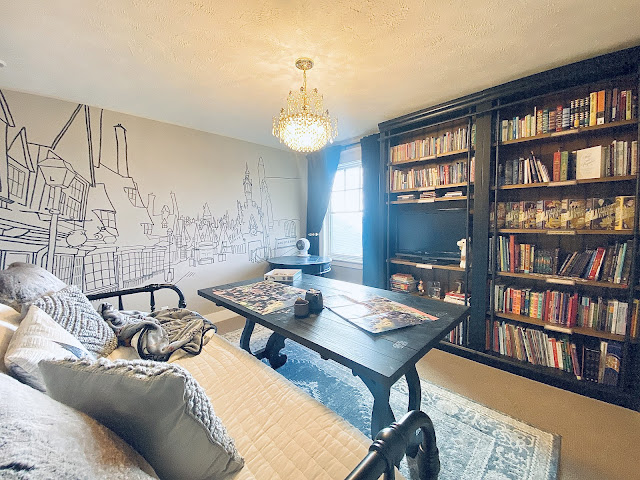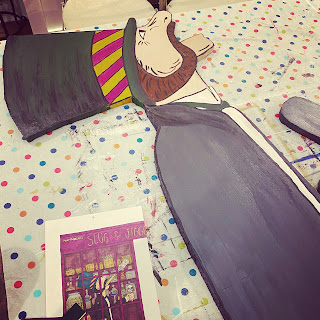Our ‘spare bedroom’ in our house has changed use over the years we have lived in our home. Initially it was a craft room where Little Tomato and I would do crafts and I would work on art projects. As we began to finish out our basement, we converted the room to a playroom that held all of her toys. Now that Little Tomato has grown out of toys, we are giving it a final upgrade.
I considered how we would use the room going forward. While we don’t have a guest bedroom, and it would be nice to have a room for guests to stay in the future, most of our families live nearby and I did not want to dedicate a space to something that would be used so sparingly. So I considered how we would best utilize the room.
Little Tomato is an avid reader, and has accumulated an impressive collection of books. Consequently, between her books and ours, we never seem to have enough bookshelves. And we both enjoy jigsaw puzzles; it is our favorite winter activity while Dad is watching sports! It would be advantageous to have a table dedicated to puzzles to avoid taking over the dinner table. Thus, I focused on a design that would support these interests- literature, puzzles, and the flexibility to accommodate guests.
I researched furniture options within budget and mocked them up together in Keynote to get a quick impression of how they look together.
I selected a daybed (with trundle) to accommodate guests when needed, as well as providing a seat for reading & puzzling. I selected a table with a folding top. The table can be positioned in front of the daybed and opened to use for puzzling or games, but can be folded and moved against the wall as a console table when the room is used for guests. And the bookshelves I selected absolutely maximize our space constraints (width AND height) along the wall to accommodate as many books as possible.*
*Remember the Pythagorean Theorem (A squared + B squared = C squared)? This equation is immensely useful to determine if a bookshelf is too tall to fit in your room. As a purely hypothetical example… You have a 96″ ceiling, and there is a 94″ tall bookshelf you want to buy, but your husband is super concerned that you won’t be able to clear the ceiling when you tip it upright and he thinks you should play it safe and get shorter bookshelves… you can determine that the tallest point when tipped = the square root of (depth (squared) + height (squared)). And that *hypothetical* 94″H x 15″D bookcase will *just* clear your 96″ ceiling (at 95.2″H diagonal when tipping it up).
Once the furniture was selected, I did a quick SketchUp model of the layout of the space to determine the best configuration.
Next I focused on the big empty wall without furniture. The window pours a lot of great natural light onto this wall, and I felt it needed a big graphic. However, a full wall of wallpaper gets very expensive, and frankly, too busy. With the detail on the rug, I needed something more simple.
I decided to paint a mural instead. I liked the idea of something literature based, since books are so central to the room’s design. Little Tomato was really pushing for a Harry Potter theme, so I conceded. I mocked up a ‘Hogwarts & surrounding areas’ map in Photoshop and determined it was too busy. Then I saw a sketchy cityscape wallpaper mural on Etsy and determined that format would be perfect. I settled on a view of Hogsmeade with the cattywampus rooflines and chimneys, and a hint of the castle in the background.
I edited the proportions of a photo in Photoshop so the layout would properly scale on my wall dimensions. I printed the edited photo out and used trace paper over it to get the perspective correct for my sketch.
After several sketches, playing with the level of detail and sketch style...

Once I settled on the final sketch, I scanned it into my computer and projected it onto the wall… where I hit a bit of a snag. With the compact room size, I couldn’t back up the projector far enough for the image to fit properly on the wall. Even with lens adjustments, I just didn’t have enough distance. So I had to get creative and angle the projector *just so* in the farthest corner of the room to get as close as possible to the needed size. I used a pencil to sketch the basic outline, using minimal line work. Then I utilized additional reference photos of the street view to continue the buildings in the foreground where the initial image no longer properly filled out the wall space. This definitely added additional time to the prep work, but couldn’t be helped.
Once the layout was done in pencil, I began the slow process of painting using a paint sample can and a couple of varying sizes of paintbrushes.

A note on paint choice: On a previous wall mural I used Sharpie Paint Pens. While this would have been immeasurably faster and easier, it has a completely different final look. The Sharpie pens use an oil based paint and have a high gloss sheen. This provides a very stark contrast to the wall eggshell finish. The colors of paint pens are also limited. The Sharpie black is true deep black. I chose a latex ‘charcoal’ paint color which has an eggshell finish similar to the wall color. This, and the softer edge of the paintbrush, provided a more ‘hand drawn’ and natural sketch effect than the (easier) paint pens.

I kept the initial sketch and my phone with reference images handy during the painting process, adding details and adjusting as needed. I utilized the larger paintbrush for the foreground building outlines and then switched to a smaller paintbrush as I painted the background buildings and foreground details. Initially I considered filling in the signage in the foreground buildings (shop names & signs), but determined that it took away from the overall image. You can see the ‘Honeydukes’ sign filled in above, but that it was painted over in the final mural.
Once the mural was completed, I used the ‘wall color’ paint to go back and touch up over the exposed pencil lines. While an eraser does remove pencil lines, it changes the sheen/texture of the paint which is noticeable when natural light hits the wall.

The aforementioned bookcases were shockingly in stock and have been hoisted up the flight of stairs and set in place.* However, the other furniture is still yet to be delivered. We are slowly filling the bookshelves, and I am working on the artwork for the opposite wall while we wait for the other furniture to arrive. I will post a final walkthrough of the completed room once it is all here and set up. We are excited to start using it as our new space!
*A shoutout to my brother for helping with that heavy chore!

















































